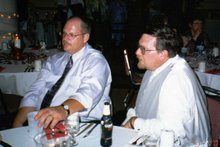I offer these tips.
All Champagnes are sparkling wines, but sparkling wines are neverIf your Mogen David has started to show bubbles you have left it on the cellar steps too long. Buy another gallon.
Champagne unless they are produced in the french region of Champagne.
Born in the most northern appellation in France, the region of ChampagneThe other grapes refer to these as "thug grapes," because of the neighborhood from which they come.
makes wines that are the product of a chalky soil and an austere climate.
While Champagne’s early wines occasionally developed a momentary bubble,Due to a worldwide natural cork shortage some bottlers now use a plastic stopper. Truly fine sparkling wines never have screw tops and a straw for you to "Bubble it yourself."
they were essentially still wines until the 17th century when the cork was
introduced, a contribution usually credited to a Benedictine monk named Dom
Perignon. Only then was it possible to keep the magical bubble in the
bottle.
The grapes that make this glorious wine are the white Chardonnay and twoMuch like Paul McCartney and Michael Jackson. Black and white combine to make a product that is predominantly white.
black grapes – Pinot Noir and Pinot Meunier, with the later used primarily in
France.
After the new cuvée is completed, it is bottled with a very small amount ofSecondary fermentation will also occur in your cousin, Ray-Ray about 10:30 Monday night. Someone should be assigned to keep him away from the crab dip, the liquor cabinet and your wife's friend Wanda.
sugar and yeast dissolved in wine and called the liqueur de tirage. This
solution is responsible for starting the next major step in Champagne making –
the second (secondary) fermentation.
Still a wine, the bottles are stored in the cellars for at least one yearHeath Ledger has been chosen to do the job of The Joker and Dick Cheney has taken on the role of The Penguin.
and often longer. At the end of that time, the wine has undergone its secondary
fermentation. The bubbles are in the bottles, but so is the sediment, which the
fermentation has deposited. To remove the French have developed a slick way to
remove it. The bottles are placed in a pupitre, or also known as riddling rack,
with their necks slightly downward. Each day skilled workmen twist the bottles
and tilt it farther down to force the sediment into the neck next to the cork.
This process is called the remuage. When all the sediment has been worked into
the neck, the wine is ready for its dégorgement. In modern facilities this
delicate operation is made with robots. (riddling machines),
computer-controlled, reproduce the meticulous work of the riddler.
To recap:Sweetness of Champagne
The amount of sugar to be added to each type of Champagne is determined by the individual Champagne maker. Generally, however, the standards are not so very different and the designation on Champagne’s label will help you to know how sweet or dry it is.
1. Brut is usually the best choice for an apéritif; it contains almost no sugar.
2. Extra Sec or Extra Dry, despite the name, is very slightly sweet.
3. Sec, which means dry in French, actually refers to a fairly sweet wine in Champagne terminology.
4. Demi-sec and Doux are both very sweet and excellent choices for a dessert wine. They are rarely shipped to North America.
"Brut" on the label is okay. "Bluto" on your label is generally bad.
"Extra Dry" Means "Not Dry"
"Sec" is sweet. Sex is Sweeeeeet!
Demi-sec is reserved for Ashton Kutcher.
All Champagne should be served chilled in a tulip-shaped or all-purposeThe old movies were wrong. Get over it and use those glasses for an appletini or something.
glass rather than a wide, shallow saucer-shaped one, which dissipates the
bubbles too quickly.
To open, wrap a towel or napkin around the bottle to keep the cork fromNever give the bottles to someone who is likely to holler, "Hey! Watch this!" before pulling the cork. Ray-Ray should not be allowed to toast the crowd wrapped in a towel, either.
flying out and causing injury. Hold the bottle at a 45-degree angle, remove the
wire, grasp the cork firmly and turn the bottle working the cork out slowly,
with a whisper, not a bang. You lose fewer bubbles that way. And bubbles, after
all, is what Champagne is all about. Once the cork is removed, take off the
towel. No wine or Champagne should be served wrapped in a towel.
A few more tips from the old grumps.
Beware of cheap imitations. If the words "Reconstituted," "From Concentrate," or "Now With Extra Pulp," appear on the label you should probably take a pass.
No truly great Champagne costs less than $25 a case, even if it says "Premium" on the carton.
Box wine may be okay for that Chardonnay your sister-in-law Darlene has been swilling all night but Champagne in a box is just vinegar waiting to happen.
Cheap Champagne or fine; kiss someone you love at Midnight and make a wish. Designate a driver. Have the happiest of New Years. I'll see you on the other side.



No comments:
Post a Comment